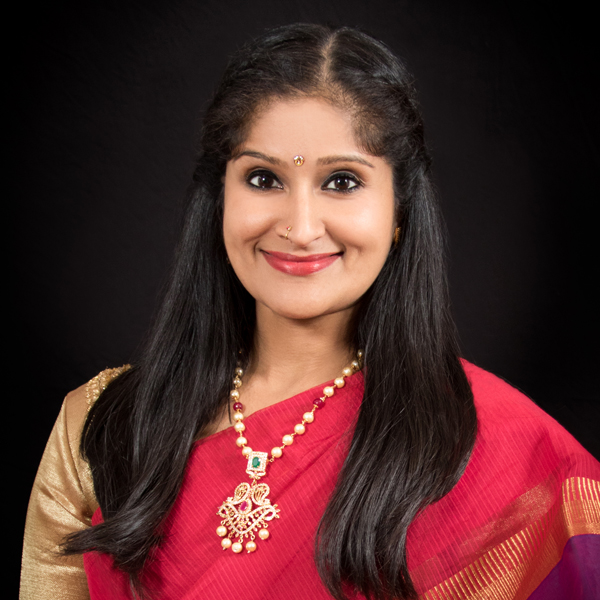About Rachita Nambiar:
Rachita Nambiar of Dauphin County, PA, practices and teaches Bharatanatyam dance, an intricate, centuries-old classical dance tradition from southern India. In September 2020, she spoke with folklorist Amy Skillman about the joy she finds in dancing and in working with the next generation of dancers.
Her name is pronounced Rah-CHEE-tah NAHM-bee-ahr, and the dance form is bah-ruh-taa-NAA-tee-uhm.

portrait of Rachita Nambiar by EG Photography
About Rachita Nambiar
Telling stories without words
Grace, strength and precision combine with engagingly expressive facial features, stunning costumes and lively music to bring Hindu mythology to life — this is Bharatanatyam dance.
If you like a good story, you will love this art form. But you will need to pay attention. The details of the story are in the hand gestures and facial expressions, which Rachita Nambiar has more than mastered. Her performances, and those of her students, show that this ancient traditional art form is as relevant today as it was two hundred or even a thousand years ago. It has found resonance in any era. And it’s as central to Rachita’s life as breathing.

Rachita Nambiar performs for Center Stage, Penn State Hershey - photo courtesy of the artist
Rachita began dancing as a young girl in Pune (POOH-nah), in central western India, under the tutelage of Dr. Mrs. Sucheta Chapekar, a well-known teacher of Bharatanatyam who is still dancing at 71 years of age. Rachita completed her arangetram (a dancer’s debut public performance after years of private instruction) in Pune before her father moved the family to Chennai in southeastern India. In Chennai, the heart of Bharatanatyam, she furthered her training under Natyakalabhushanam the late Mrs. Nirmala Ramachandran, a popular exponent of abhinaya or the art of expression.
Nritta • Nritya • Natya
All Bharatanatyam dancers must master three key components: nritta (pure technical aspects of the dance), nritya (expression or abhinya of the dance), and natya (drama, where the technical aspects come together with the expression). “The dramatics that the dance form brings to the stage are so compelling that the audience ... is just amazed by what they see. The face of the dancer is telling so much with their expression that I think it is relevant even today. And it is such a beautiful art form, with so many components...”
“...It is telling a story every time you stand on stage.”
The story has multiple levels: the ancient narratives of rascals and warriors passed down through generations ... the story of a community holding onto what is most beautiful about their culture ... and the tale of a young girl pursuing her passion as a dancer.
Resurgence of a 2000-year-old dance tradition
Bharatanatyam originated in the Tamil Nadu state of southeast India. The earliest description is found in an epic from the 2nd Century Common Era, but most scholars believe it is over 2000 years old. The dance was initially performed only in the temples for ritual purposes by the devadasis. A devadasi [servant (dasi) of divinity (deva)] was an artist who dedicated her artistic services to the temple and who maintained the traditions through teaching and practice from generation to generation. The dance was supported through the patronage of kings and rajas who enjoyed the dance so much that it eventually found its way onto the public stage.
Under British rule (1858–1947), propaganda against all things Indian began to portray the dance as crude and inferior to the concepts of Western civilization. This influence alienated the patronage of royal courts and dissuaded Indian families from practicing their traditions. Eventually the devadasi system declined and by the early 20th Century, this beautiful classical dance had almost disappeared. Fortunately a few families bravely kept the traditions alive and by the middle of the 20th Century, dance schools were being re-established all over India. The end of British rule brought renewed support for things Indian and Bharatanatyam returned to its current status as a revered dance tradition emblematic of India’s best artistic practices. (More history and context at www.rangashree.org)

photo by EG Photography
“My whole life growing up has been learning dance.”
Rachita grew up in an arts family. Her mother played the veena, a stringed instrument essential to the Bharatanatyam orchestra, and her father was a connoisseur of Carnatic music (a system of music particular to southern India). “I grew up in a family where there was a lot of support towards classical arts. And so I always had that backing.” She continued her education, pursuing a BA in Nutrition and an MA in Biochemistry, but she never stopped dancing. “I always knew. I had that love for science, but I also knew that I never wanted to quit dance. I was very clear during my college years that I never wanted to give up dance.”
Teaching the next generation in America
Rachita met her husband in 2000 and they came to the US in 2001, settling first in West Virginia and then Delaware before finally moving to Harrisburg, PA in 2006. Two months after the birth of her second daughter, Rachita gave a performance at the HARI (Hindu American Religious Institute) Temple in New Cumberland, PA. It was well received and she was flooded with requests to teach, so she began leading classes in the temple. Soon she had so many students that they had to find a studio space, and the Rasika School of Dance came into being.
The South Asian community is quite large in central Pennsylvania, and Bharatanatyam dance is one way that Indian immigrant communities are able to hold onto their cultural identity. Through dance, the generation growing up in America learns important history, values, aesthetics and beliefs. As Rachita says, “I love to pass this down to the next generation... It should be taught; it should be made visible to other people...”

photo by Quang Phan (Win Photography)
Rasika, the name of the school, means to appreciate or to enjoy, and that is Rachita’s goal. In the U.S., where her audience might not be familiar with Bharatanatyam, it is especially important for her (and her students) to engage that audience in ways that foster appreciation as well as enjoyment. She explains, “There is no dancer if there is no audience... When you don’t get that encouragement or you don’t get that feedback from your audience, there is no dancer.”

photo courtesy of the artist
“I love to pass this down to the next generation... It should be taught; it should be made visible to other people”
From dancer to teacher
To teach Bharatanatyam, it is necessary to know the nattuvangam, or vocal percussion: a rhythmic recitation with hand cymbals that guides the dancer. Rachita says, “I was fortunate enough to get training separately in vocal percussion, so I could assist my guru, sit behind her on stage, and gain some confidence.”
The vocal percussion must be completely synchronized with the dancer’s bells worn around her ankles. The bells, in turn, align with her footwork. A teacher with a strong command of the vocal percussion can guide the student’s footwork to align with the mridangist, the drummer in the orchestra. “The footwork is the connection between the bells, the nattuvangam, and the mridangist. So, unless you have this symphony between these three elements, your dance is going to be off.”

photo courtesy of the artist
“I always think about my audience. How do I make it relevant?”
Innovation within an ancient tradition
“For me, as an artist, even though it is an ancient dance form that originated in India... when I perform, I always think about my audience. How do I make it relevant? ... Bharatanatyam can be used to tell any story; not just the stories of India.”
Rachita has created a program called Creative Movements, where she selects a well-known children’s story and tells the story using facial expressions and hand gestures from the Bharatanatyam tradition. But she doesn’t just tell the story. She teaches the children to use their own facial expressions and hand gestures to join her in telling the story. “So story time becomes more than just reading a book. It becomes as if you are jumping into that story.” And she believes that, in that process, children are finding new and perhaps better ways to express themselves.
An intriguing collaboration with Gamut Theatre in Harrisburg, PA found Rachita designing the choreography for two dance scenes in their production of Shakespeare’s Pericles, Prince of Tyre: one for a romantic reunion and one as a victory dance. These collaborations stretch her own creativity and broaden her audience.

photo by Kelly Ann Shuler @ Gamut Theater
“Even if it is just five minutes of peace of mind; five minutes to breathe and sit back and watch something beautiful...”
“Using dance in different ways is what I love to do,” says Rachita. And she’s always looking for different ways. She has recently become part of the Penn State Hershey Medical Center’s “Center Stage” program, which is using art to offer healing experiences for their patients. “Even if it is just five minutes of peace of mind, five minutes to breathe and sit back and watch something beautiful... I feel very satisfied after that performance. I feel in some small way I have done something in that person’s life.”
A peaceful space, a happy place
With its visual richness, engaging drama and mesmerizing rhythms, Bharatanatyam dance creates a space apart, where stories of the past intersect with present-day lives. Finding that space apart seems even more important than ever in 2020, when families and communities are facing challenges on so many levels. Rachita says, “I think I have realized it more and more, as I get older, that dance is not just a physical sport...
“[Dance] is not just an exercise for the body... it is definitely an exercise for the mind... It is my happy place.”

Click to watch it on YouTube!
Visit the Rasika School of Dance at www.rasikadance.com
Learn more about Bharatanatyam dance at www.rangashree.org



Brand icons for Facebook, YouTube, Instagram and other social media platforms are the trademark of their respective owners. No endorsement is implied.